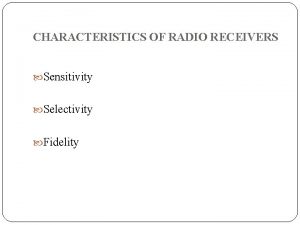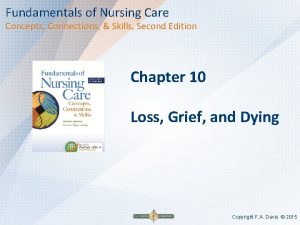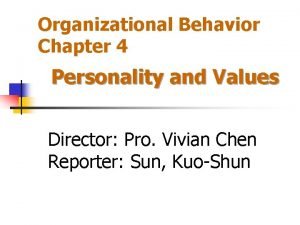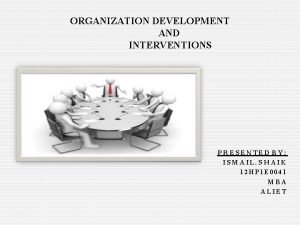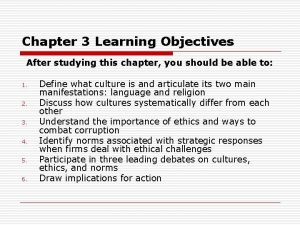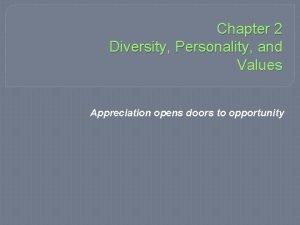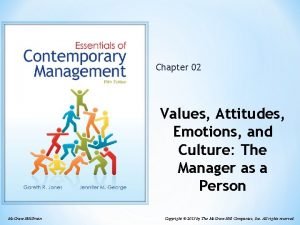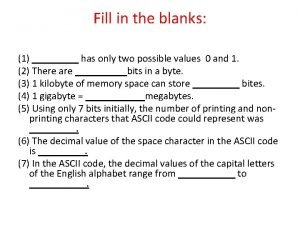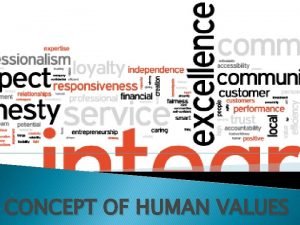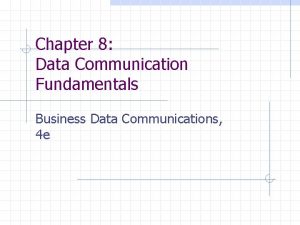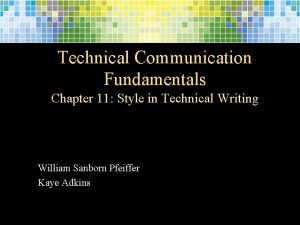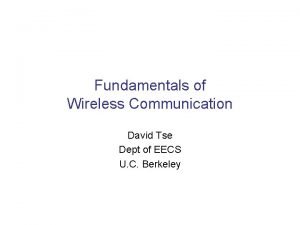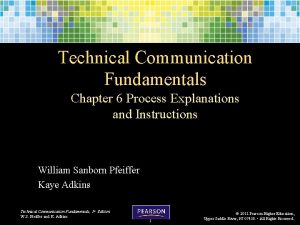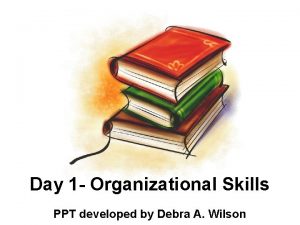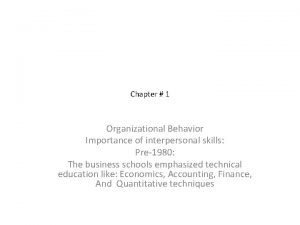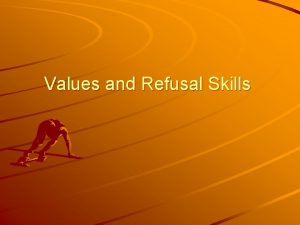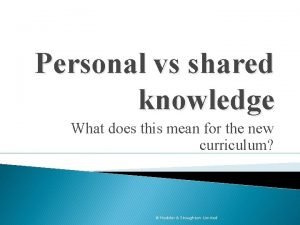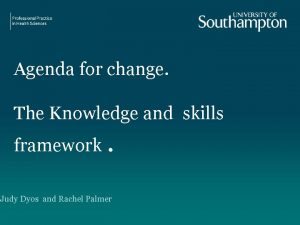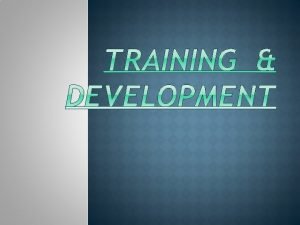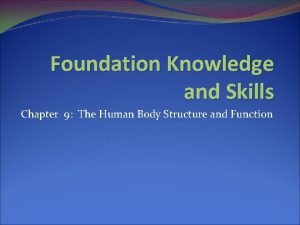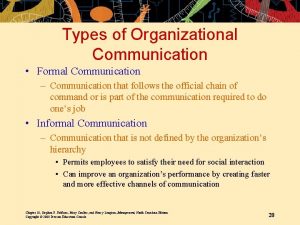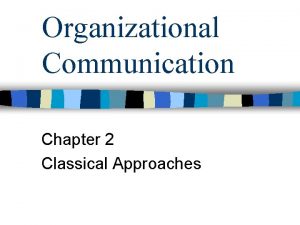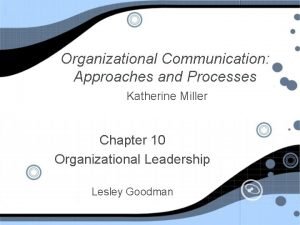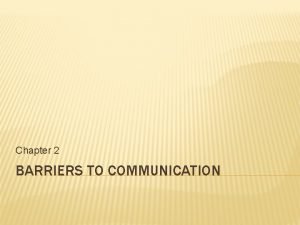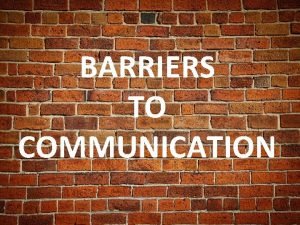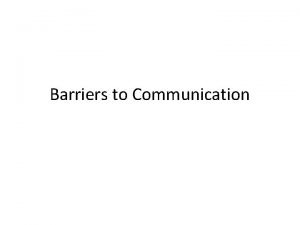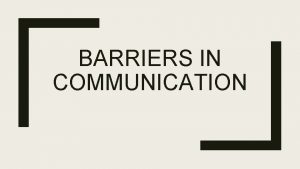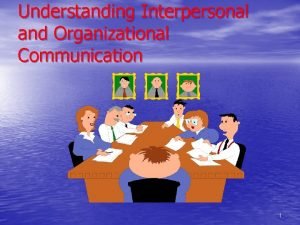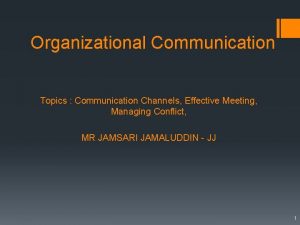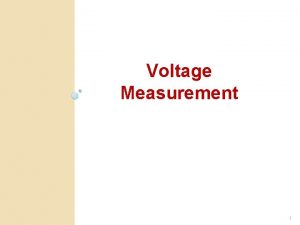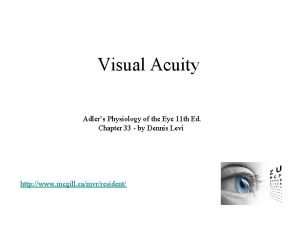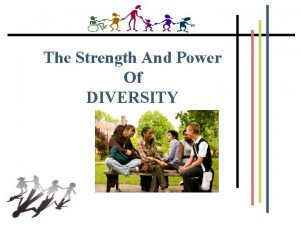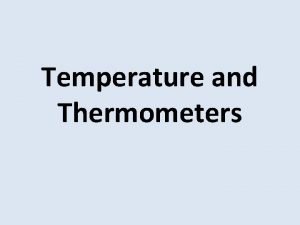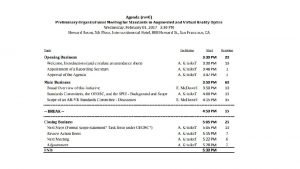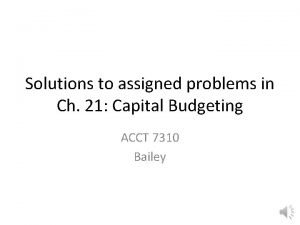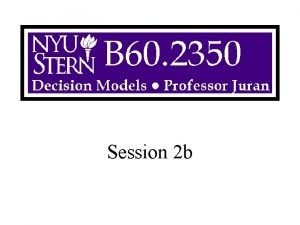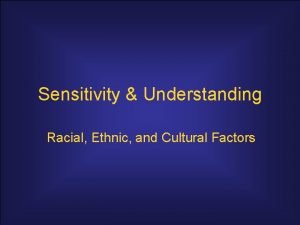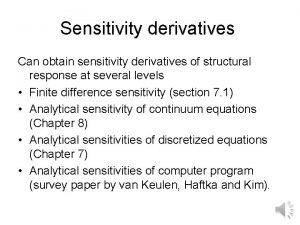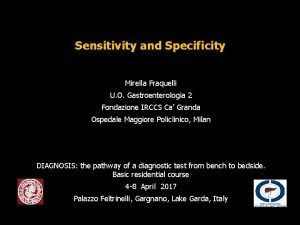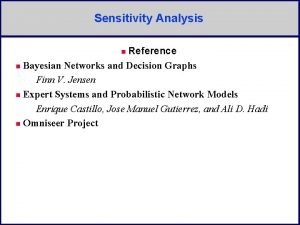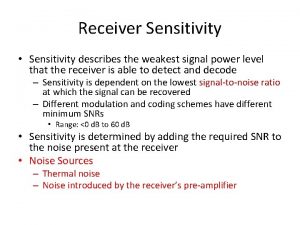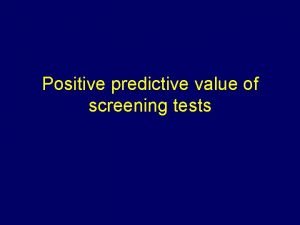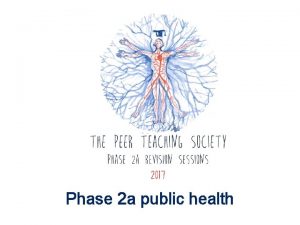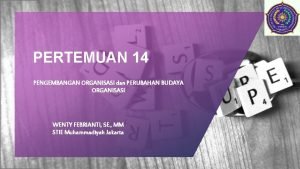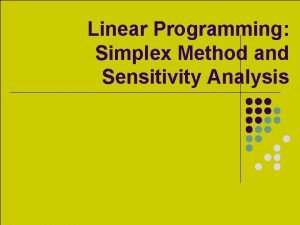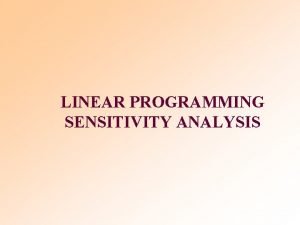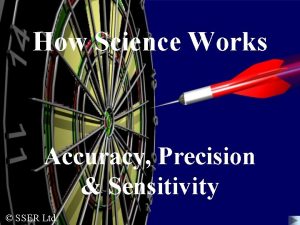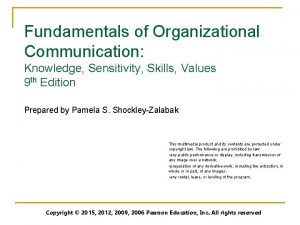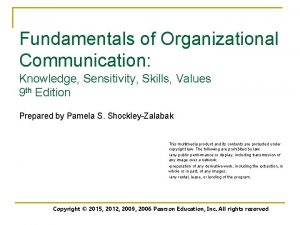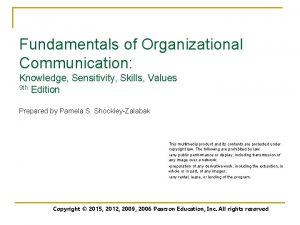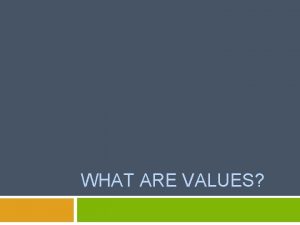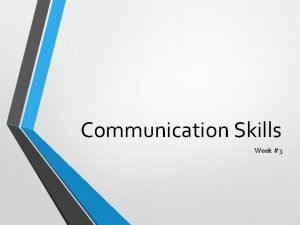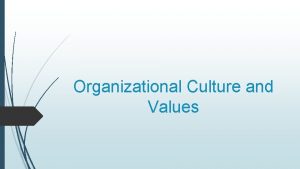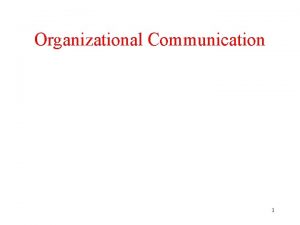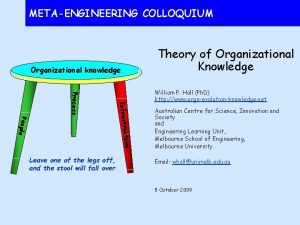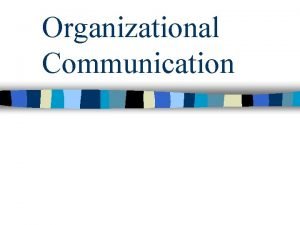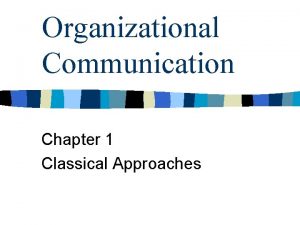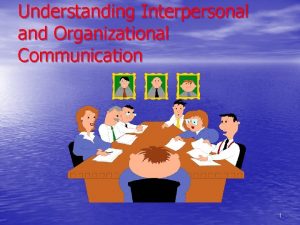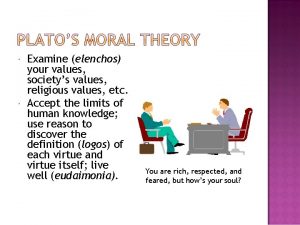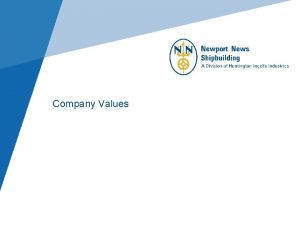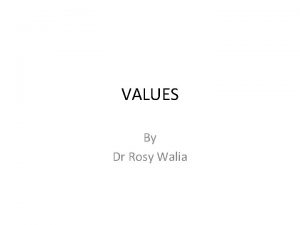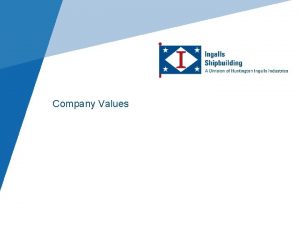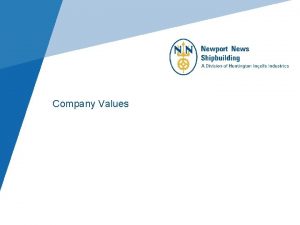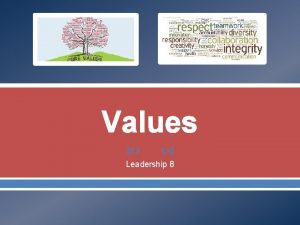Fundamentals of Organizational Communication Knowledge Sensitivity Skills Values






































































- Slides: 70

Fundamentals of Organizational Communication: Knowledge, Sensitivity, Skills, Values 9 th Edition Prepared by Pamela S. Shockley-Zalabak This multimedia product and its contents are protected under copyright law. The following are prohibited by law: • any public performance or display, including transmission of any image over a network; • preparation of any derivative work, including the extraction, in whole or in part, of any images; • any rental, lease, or lending of the program. Copyright © 2012, 2009, 2006 Pearson Education, Inc. All rights reserved Copyright © 2015, 2012, Pearson Education, rights reserved

Fundamentals of Organizational Communication A Competency Based Approach Chapter One Prepared by Pamela S. Shockley-Zalabak Copyright © 2012, 2009, 2006 Pearson Education, Inc. All rights reserved Copyright © 2015, 2012, Pearson Education, rights reserved

Goal n Develop knowledge, sensitivity, skill, and value competencies through an interaction of theory, practice, and analysis Copyright © 2012, 2009, 2006 Pearson Education, Inc. All rights reserved Copyright © 2015, 2012, Pearson Education, rights reserved

Objectives n n n Describe communication in the information-rich world Define and describe communication competency Define and describe the human communication process Identify descriptions of organizations Surveying definitions of organizational communication Copyright © 2012, 2009, 2006 Pearson Education, Inc. All rights reserved Copyright © 2015, 2012, Pearson Education, rights reserved

Objectives n n Understanding communication as a key to organizational excellence Developing awareness of our personal communication competencies Understand human communication as creating shared realities, shared meanings Distinguish among interpersonal, small group, and organizational communication Copyright © 2012, 2009, 2006 Pearson Education, Inc. All rights reserved Copyright © 2015, 2012, Pearson Education, rights reserved

Objectives n n Assess student’s personal development needs Practice analysis capabilities Copyright © 2012, 2009, 2006 Pearson Education, Inc. All rights reserved Copyright © 2015, 2012, Pearson Education, rights reserved

Challenges for Individuals and Organizations J. F. Rischard (2002) Global Rule Book Issues that need to be addressed in the next 20 years… Global Warming Biodiversity Deforestation Poverty Education Digital Divide E-Commerce Rules International Labor Migration Rules Global Financial Architecture War Terrorism Global Warming Accelerating Rates of Change Copyright © 2012, 2009, 2006 Pearson Education, Inc. All rights reserved Copyright © 2015, 2012, Pearson Education, rights reserved

The Communications Era n Nature of Innovation q n n Outsourcing Globalization Shift from informational to conceptual age q q Increase in jobs requiring communication expertise With more than half of America’s workforce and gross national product in knowledge industries, virtually all agree we are in a postindustrial information society moving to a conceptual age Copyright © 2012, 2009, 2006 Pearson Education, Inc. All rights reserved Copyright © 2015, 2012, Pearson Education, rights reserved

Key Terms n Information society - environment in which more jobs create, process, or distribute information than directly produce goods. The environment is characterized by mass production of information, which requires the constant learning of new activities and processes. Copyright © 2012, 2009, 2006 Pearson Education, Inc. All rights reserved Copyright © 2015, 2012, Pearson Education, rights reserved

Key Terms n Conceptual age – environment in which inventive, empathetic, big-picture capabilities will be required for the most fulfilling jobs. Written and oral communication, inquiry, critical and creative thinking, qualitative literacy, cultural knowledge, teamwork, synthesis of learning, and strong personal ethics will be highly valued. Copyright © 2012, 2009, 2006 Pearson Education, Inc. All rights reserved Copyright © 2015, 2012, Pearson Education, rights reserved

Jobs of the Conceptual Age § Teacher § Lawyer § Media § Writer § Medicine § Engineering § Finance Copyright © 2012, 2009, 2006 Pearson Education, Inc. All rights reserved Copyright © 2015, 2012, Pearson Education, rights reserved

The Communications Era n Characterized by rapid change associated with mass production of information, change requiring consistent involvement in the learning of new activities, processes and technologies Copyright © 2012, 2009, 2006 Pearson Education, Inc. All rights reserved Copyright © 2015, 2012, Pearson Education, rights reserved

Tools That Change the Way We Work § § § § § Wireless Networks Fiber-Optic Connections Global Telecommunications Discs Email Credit Card/Electronic Transactions Cell Phone Satellites Internet/Social Networking Copyright © 2012, 2009, 2006 Pearson Education, Inc. All rights reserved Copyright © 2015, 2012, Pearson Education, rights reserved

Term of the day n Convergence q n Computing, wireless technologies, and more traditional media such as television converging into integrated tools for work, school, family, and leisure environments Our challenge… q Avoid information overload by learning how to deal with increasing information alternatives Copyright © 2012, 2009, 2006 Pearson Education, Inc. All rights reserved Copyright © 2015, 2012, Pearson Education, rights reserved

Communication: The Key to Organizational Excellence n n Organizational excellence stems from dedicated people who are motivated to work together and who share similar values and visions about the results of their efforts. Numerous scholars have suggested that organizations are essentially complex communication processes that create and change events. Copyright © 2012, 2009, 2006 Pearson Education, Inc. All rights reserved Copyright © 2015, 2012, Pearson Education, rights reserved

Communication: The Key to Organizational Excellence n Research has linked organizational communication to q Managerial effectiveness q The integration of work units across organizational levels q Job satisfaction q Innovation q Adaptability q Creativity q Overall organizational effectiveness and performance Copyright © 2012, 2009, 2006 Pearson Education, Inc. All rights reserved Copyright © 2015, 2012, Pearson Education, rights reserved

Communication: The Key to Organizational Excellence n n With more rapid change, more information, less certainty about complex decisions, organizations need competent communicators at all organizational levels. Communication scholars and active organizational members must work together to understand what contributes to organizational communication competency Copyright © 2012, 2009, 2006 Pearson Education, Inc. All rights reserved Copyright © 2015, 2012, Pearson Education, rights reserved

Excellence in Communication: Communication Competency n n Michael Hackman and Craig Johnson (2004) identified a contemporary “good communicator” theme when reviewing research from personnel administrators throughout the United States of America. Today’s organizations need people who are flexible and creative people who have diverse and well-developed communication abilities. q How do we determine if we are competent organizational communicators? q Who decides? q On what do we base our conclusions? Copyright © 2012, 2009, 2006 Pearson Education, Inc. All rights reserved Copyright © 2015, 2012, Pearson Education, rights reserved

Fred Jablin and Patricia Sias (2001) n Comprehensive discussion of communication competency, suggested that the concept of communication competency is best understood by an ecological model that revolves around four systems: Copyright © 2012, 2009, 2006 Pearson Education, Inc. All rights reserved Copyright © 2015, 2012, Pearson Education, rights reserved

Fred Jablin and Patricia Sias (2001) Globalization Technology Globalization Technology Globalization The Microsystem Technology Immediate work environment Globalization Technology Globalization Technology The Exosystem Globalization Technology Globalization The Mesosystem Overarching cultural belief Technologysystem, forms of knowledge, Interrelations among various Globalizationsocial, Technology Globalization microsystems technological and Technology political ideologies Globalization Technology The Macrosystem Globalization Technology Major divisions of the organization Technology and the Globalization Technology Globalization organization itself as a whole Technology Globalization Technology Copyright © 2012, 2009, 2006 Pearson Education, Inc. All rights reserved Copyright © 2015, 2012, Pearson Education, rights reserved Globalization Technology

Sherry Morreale (2008) Communication Competency Linkage between communication competence and ethics. Specifically, she identifies issues of competence related to pursuing selfinterest versus the interest of others, to engaging in information sharing versus manipulation, and to recognizing the longterm effects of communication across time and diverse relationships. Copyright © 2012, 2009, 2006 Pearson Education, Inc. All rights reserved Copyright © 2015, 2012, Pearson Education, rights reserved

Stephen Littlejohn and David Jabusch (1982) n n Communication competency involves our personal willingness and ability to communicate so that our meanings are understood and we understand the meanings of others. Involves interaction of three primary elements: q q q Theory Practice Analysis Copyright © 2012, 2009, 2006 Pearson Education, Inc. All rights reserved Copyright © 2015, 2012, Pearson Education, rights reserved

Perception of Competency is Relative n n My impression of my own competency and the competency of others is related to my evaluation of whether we exhibited the “right” behaviors and achieved “desirable” results in a particular situation. How do we prepare for future communication needs? Copyright © 2012, 2009, 2006 Pearson Education, Inc. All rights reserved Copyright © 2015, 2012, Pearson Education, rights reserved

Future Communication Needs q Process understanding n q Interpersonal sensitivity n q Ability to perceive feelings and meanings Communication skills n q Cognitive ability to understand the dynamics of the communication event Ability to develop and interpret message strategies in specific situations Ethical responsibility n Attitudinal set that governs concern for the well-being of all participants in taking responsibility for communication outcomes Copyright © 2012, 2009, 2006 Pearson Education, Inc. All rights reserved Copyright © 2015, 2012, Pearson Education, rights reserved

Key Terms n n Organizational excellence - ability of people to work together and utilize technology for creative solving of increasingly complex problems. Communication competency - comprises knowledge, sensitivity, skills, and values. Competence arises from interaction of theory, practice, and analysis. Copyright © 2012, 2009, 2006 Pearson Education, Inc. All rights reserved Copyright © 2015, 2012, Pearson Education, rights reserved

Organizational Communication: A Competency-Based Approach n n Knowledge Sensitivity Skills Values Copyright © 2012, 2009, 2006 Pearson Education, Inc. All rights reserved Copyright © 2015, 2012, Pearson Education, rights reserved

Key Terms n Competency components q q Knowledge - the ability to understand the organizational communication environment Sensitivity - the ability to accurately sense organizational meanings and feelings Copyright © 2012, 2009, 2006 Pearson Education, Inc. All rights reserved Copyright © 2015, 2012, Pearson Education, rights reserved

Key Terms q q Skills - the ability to accurately analyze organizational situations and to effectively initiate and consume organizational messages Values - the importance of taking personal responsibility for effective communication, thereby contributing to organizational excellence Copyright © 2012, 2009, 2006 Pearson Education, Inc. All rights reserved Copyright © 2015, 2012, Pearson Education, rights reserved

Defining Communication n Communication behaviors create and shape relationships and events through a culturally dependent process of assigning meaning to symbols Copyright © 2012, 2009, 2006 Pearson Education, Inc. All rights reserved Copyright © 2015, 2012, Pearson Education, rights reserved

Key Terms n n Human communication process - attempts to construct shared realities through social interaction. Sources and receivers - individuals send messages as sources and receive messages as receivers. The process is often so rapid as to appear simultaneous. Copyright © 2012, 2009, 2006 Pearson Education, Inc. All rights reserved Copyright © 2015, 2012, Pearson Education, rights reserved

Key Terms n Encoding and Decoding - message encoding is the process of formulating messages, choosing content and symbols to convey meaning. Message decoding is the process of assigning meaning in the role of receiver to message symbols generated by the message source. Copyright © 2012, 2009, 2006 Pearson Education, Inc. All rights reserved Copyright © 2015, 2012, Pearson Education, rights reserved

Key Terms n n Message - symbolic attempt to transfer meaning; the signal that serves as a stimulus for a receiver. Channel - medium through which the message is transmitted. Copyright © 2012, 2009, 2006 Pearson Education, Inc. All rights reserved Copyright © 2015, 2012, Pearson Education, rights reserved

Key Terms n Noise - distortion of interference that contributes to discrepancies between the meaning intended by the source of a message and the meaning assigned by the receiver. Copyright © 2012, 2009, 2006 Pearson Education, Inc. All rights reserved Copyright © 2015, 2012, Pearson Education, rights reserved

Key Terms n n n Field of experience - set of specific experiences or background that all parties in communication bring to bear on the interaction. Communication context - environment for the communication interaction. Realities and Effects - result, consequence, or outcome of communication exchanges. Copyright © 2012, 2009, 2006 Pearson Education, Inc. All rights reserved Copyright © 2015, 2012, Pearson Education, rights reserved

Human Communication n Our attempts to have others understand our world as we do or as we want them to understand it and our efforts to comprehend the world of those around us. Copyright © 2012, 2009, 2006 Pearson Education, Inc. All rights reserved Copyright © 2015, 2012, Pearson Education, rights reserved

Key Terms n Reality or Effect - Created social reality or result, consequence, or outcome of communication exchanges. Copyright © 2012, 2009, 2006 Pearson Education, Inc. All rights reserved Copyright © 2015, 2012, Pearson Education, rights reserved

Communication as Constitutive of Shared Realities n Human communication is the process of attempting to construct shared realities, to create shared meanings, social interaction realities Copyright © 2012, 2009, 2006 Pearson Education, Inc. All rights reserved Copyright © 2015, 2012, Pearson Education, rights reserved

Key Terms n Shared realities - meanings resulting from the communication process; attempts to have others understand our world as we do or as we intend for it to be understood, and our efforts to comprehend the world of those around us. Copyright © 2012, 2009, 2006 Pearson Education, Inc. All rights reserved Copyright © 2015, 2012, Pearson Education, rights reserved

Robert Craig (2007) n “A first-order constitutive model of communication posits that communication, rather than merely a neutral conduit for transmitting independently existing information, is the primary social process through which our meaningful common world is constructed. ” As a process for the construction of shared realities, human communication is culturally and contextually influenced, dynamic, and ever-changing. Copyright © 2012, 2009, 2006 Pearson Education, Inc. All rights reserved Copyright © 2015, 2012, Pearson Education, rights reserved

Construction of Shared Realities to Create Shared Meaning n Interpersonal Communication q n When this process occurs between two individuals with some type of ongoing relationship Group Communication q When the process occurs among several individuals Copyright © 2012, 2009, 2006 Pearson Education, Inc. All rights reserved Copyright © 2015, 2012, Pearson Education, rights reserved

Construction of Shared Realities to Create Shared Meaning n Public/Mass Communication q n When large numbers of people are involved (either personally or through technological channels) Organizational Communication q The human communication process in organizations Copyright © 2012, 2009, 2006 Pearson Education, Inc. All rights reserved Copyright © 2015, 2012, Pearson Education, rights reserved

The Meaning of Shared Meaning n n n Shared meanings are always incomplete and characterized by ambiguity The human communication process as an attempt to construct shared realities can represent openness and clarity but also be characterized by manipulation, control, or deceit The construction of meaning is an intentional process between us related to our knowledge, sensitivity, skills, and values Copyright © 2012, 2009, 2006 Pearson Education, Inc. All rights reserved Copyright © 2015, 2012, Pearson Education, rights reserved

21 st Century Concepts of Organizations Key Terms n Organization - result of the process of organizing; dynamic system in which individuals engage in collective efforts for goal accomplishments. Copyright © 2012, 2009, 2006 Pearson Education, Inc. All rights reserved Copyright © Pearson Education, rights reserved 2015, 2012,

Amitai Etzioni (1964) n n Organizations are social units or groupings of people deliberately constructed and reconstructed to strive for specific goals Characterized by divisions of labor for goal achievement Directed by relatively continuous patterns of authority and leadership Complex interdependence among internal and external components requires coordination through communication Copyright © 2012, 2009, 2006 Pearson Education, Inc. All rights reserved Copyright © 2015, 2012, Pearson Education, rights reserved

Key Terms n Organizational communication - process through which organizations are created and in turn create and shape events. The process can be understood as a combination of process, people, messages, meaning, and purpose. Copyright © 2012, 2009, 2006 Pearson Education, Inc. All rights reserved Copyright © 2015, 2012, Pearson Education, rights reserved

Organizational Communication as a Process n n n An on-going process without distinct beginnings and ends. The process includes patterns of interactions that develop among organizational members and those external to the organization and how these interactions shape organizations Evolutionary Culturally dependent Copyright © 2012, 2009, 2006 Pearson Education, Inc. All rights reserved Copyright © 2015, 2012, Pearson Education, rights reserved

Organizational Communication as a Process n The on-going process of creating and transmitting organizational messages reflects the shared agreements and disagreements resulting from previous message exchanges and evolves to generate new realities that create and shape events Copyright © 2012, 2009, 2006 Pearson Education, Inc. All rights reserved Copyright © 2015, 2012, Pearson Education, rights reserved

Organizational Communication as a Process n In… q q q q Developing strategy, Planning, Decision making and executing work During unexpected crises Changes in the external environment Encounters with competitors, A host of less visible ways Copyright © 2012, 2009, 2006 Pearson Education, Inc. All rights reserved Copyright © 2015, 2012, Pearson Education, rights reserved

Organizational Communication as a Process n Between… q n Individuals performing daily work or socializing And includes… q Messages to large numbers of n n n Employers Customers Stakeholders All these interactions taken together create and shape the on-going organization Copyright © 2012, 2009, 2006 Pearson Education, Inc. All rights reserved Copyright © 2015, 2012, Pearson Education, rights reserved

Organizational Communication as People n Individuals bring to organizations sets of characteristics that influence how information is processed. Organizational communication contributes to creating relationships and assists both individuals and organizations in achieving diverse purposes. Copyright © 2012, 2009, 2006 Pearson Education, Inc. All rights reserved Copyright © 2015, 2012, Pearson Education, rights reserved

Organizational Communication as People n Organizational communication occurs between and among people who… q q share both work and interpersonal relationships are geographically separated may speak different languages and have widely differing cultural perspectives exist across networks and need to obtain a variety of objectives requiring communication interactions Copyright © 2012, 2009, 2006 Pearson Education, Inc. All rights reserved Copyright © 2015, 2012, Pearson Education, rights reserved

Organizational Communication as Messages n Organizational communication is q q q the creation and exchange of messages the movement or transmission of verbal and nonverbal behaviors the sharing of information throughout the organization Copyright © 2012, 2009, 2006 Pearson Education, Inc. All rights reserved Copyright © 2015, 2012, Pearson Education, rights reserved

Organizational Communication as Messages n n Communicators are linked together by channels, and messages described with such terms as frequency, amount, and type Concern is expressed for message fidelity, or the extent to which messages are similar or accurate at all links through the channels Copyright © 2012, 2009, 2006 Pearson Education, Inc. All rights reserved Copyright © 2015, 2012, Pearson Education, rights reserved

Organizational Communication as Messages n Organizational messages are increasingly telemediated (using complex technologies) which… q q q extend their geographic reach change notions of time and space alters who participates in communication processes Copyright © 2012, 2009, 2006 Pearson Education, Inc. All rights reserved Copyright © 2015, 2012, Pearson Education, rights reserved

Organizational Communication as Meaning n n Organizational communication creates and shapes organizational events Role taking occurs as individuals engage in social interaction within the ever-changing organizational context Copyright © 2012, 2009, 2006 Pearson Education, Inc. All rights reserved Copyright © 2015, 2012, Pearson Education, rights reserved

Organizational Communication as Meaning n n Organizational communication creates and shapes organizational events Role taking occurs as individuals engage in social interaction within the ever-changing organizational context Copyright © 2012, 2009, 2006 Pearson Education, Inc. All rights reserved Copyright © 2015, 2012, Pearson Education, rights reserved

Organizational Communication as Meaning n Organizational communication… q q Is the symbolic behavior of individuals and organizations that, when interpreted, affects all organizational activities Does not create a singular set of meanings for organizational members and activities n The interactions of ever-changing behaviors often create multiple perceptions of events and multiple realities that become the process through which organizational meanings are generated Copyright © 2012, 2009, 2006 Pearson Education, Inc. All rights reserved Copyright © 2015, 2012, Pearson Education, rights reserved

Organizational Communication as Constitutive of Organizations n Organizational communication… q q q Is organizing, decision making, planning, controlling, and coordinating Seeks to reduce environmental uncertainty Is people, messages, and meaning Is intentional and unintentional messages explaining the workings of the organization. Reflects the purpose of the organization Copyright © 2012, 2009, 2006 Pearson Education, Inc. All rights reserved Copyright © 2015, 2012, Pearson Education, rights reserved

Organizational Communication as Constitutive of Organizations n Organizational communication… q Is the process through which individuals and organizations attempt goal-oriented behavior in dealing with their environments. Copyright © 2012, 2009, 2006 Pearson Education, Inc. All rights reserved Copyright © 2015, 2012, Pearson Education, rights reserved

Stanley Deetz (1994) n “Communication, in the view I am suggesting, refers to the social processes by which meanings, identities, psychological states, social structures, and the various means of the contact of the organization with the environment are both produced, reproduced, or changed. In both its constitutive and reproductive modes, communication processes are central to how perceptions, meanings, and routines are held in common. In all interactions, including those in organizations, perception, meaning, and data transmission are all complex, multileveled phenomena produced out of and producing conflicting motives and structures” (p. 90) Copyright © 2012, 2009, 2006 Pearson Education, Inc. All rights reserved Copyright © 2015, 2012, Pearson Education, rights reserved

Discussion Question #1 n What unusual communication demands are placed on the “competent communicator” today’s organizations? Copyright © 2012, 2009, 2006 Pearson Education, Inc. All rights reserved Copyright © 2015, 2012, Pearson Education, rights reserved

Discussion Question #2 n How will you, as a “competent communicator” use each of the four components of competency (knowledge, sensitivity, skills, and values) in your personal and professional life? Copyright © 2012, 2009, 2006 Pearson Education, Inc. All rights reserved Copyright © 2015, 2012, Pearson Education, rights reserved

Discussion Question #3 n Describe a person you consider to be a “competent communicator” and describe how he or she demonstrates the four components of competency (knowledge, sensitivity, skills, and values). Copyright © 2012, 2009, 2006 Pearson Education, Inc. All rights reserved Copyright © 2015, 2012, Pearson Education, rights reserved

Discussion Question #4 n If communication competence is the key to organizational excellence, how would you encourage the members of an organization to become competent communicators? Copyright © 2012, 2009, 2006 Pearson Education, Inc. All rights reserved Copyright © 2015, 2012, Pearson Education, rights reserved

Discussion Question #5 n Communication competency is described as a combination of knowledge, sensitivity, skills, and values. If you had to do without one of these components, which would you think was most dispensable? If you could add a fifth component, what might be added? Copyright © 2012, 2009, 2006 Pearson Education, Inc. All rights reserved Copyright © 2015, 2012, Pearson Education, rights reserved

Discussion Question #6 n Describe what is meant when one says that communication is to be understood as a process. Copyright © 2012, 2009, 2006 Pearson Education, Inc. All rights reserved Copyright © 2015, 2012, Pearson Education, rights reserved

Discussion Question #7 n Describe a communication event in which you participated or observed. Identify and describe the sources/receivers, channels, noise, competence, experience, context, and effects that made up the event. Copyright © 2012, 2009, 2006 Pearson Education, Inc. All rights reserved Copyright © 2015, 2012, Pearson Education, rights reserved

Discussion Question #8 n Since we all play a part in creating the “shared realities” of our organizations, what ethical responsibilities should we recognize and assume? Copyright © 2012, 2009, 2006 Pearson Education, Inc. All rights reserved Copyright © 2015, 2012, Pearson Education, rights reserved

Discussion Question #9 n Describe an occasion when you observed the members of an organization using communication to create and shape an event. Copyright © 2012, 2009, 2006 Pearson Education, Inc. All rights reserved Copyright © 2015, 2012, Pearson Education, rights reserved

Discussion Question #10 n Generate your own definition of the terms “organization” and “organizational communication. ” Copyright © 2012, 2009, 2006 Pearson Education, Inc. All rights reserved Copyright © 2015, 2012, Pearson Education, rights reserved
 Fundamentals of organizational communication 9th edition
Fundamentals of organizational communication 9th edition Fundamentals of organizational communication 9th edition
Fundamentals of organizational communication 9th edition Selectivity in communication system
Selectivity in communication system Fundamentals of nursing care concepts connections & skills
Fundamentals of nursing care concepts connections & skills Proactive personality
Proactive personality Objectives of development
Objectives of development Western vs eastern values
Western vs eastern values Machiavellian personality
Machiavellian personality Terminal values and instrumental values
Terminal values and instrumental values It can only have one of two possible values: 0 or 1.
It can only have one of two possible values: 0 or 1. Concept of human values
Concept of human values Material and non material culture examples
Material and non material culture examples Fundamentals of data communication
Fundamentals of data communication Style of technical communication
Style of technical communication Fundamentals of wireless communication solution
Fundamentals of wireless communication solution Technical communication fundamentals
Technical communication fundamentals Organizational skills ppt
Organizational skills ppt Organizational and interpersonal skills
Organizational and interpersonal skills Ideas about values qualities and skills
Ideas about values qualities and skills What is shared knowledge
What is shared knowledge Knowledge shared is knowledge squared meaning
Knowledge shared is knowledge squared meaning Knowledge shared is knowledge multiplied meaning
Knowledge shared is knowledge multiplied meaning Knowledge creation and knowledge architecture
Knowledge creation and knowledge architecture Contoh shallow knowledge dan deep knowledge
Contoh shallow knowledge dan deep knowledge Posteriori proposition
Posteriori proposition Book smart vs street smart
Book smart vs street smart Knowledge claim
Knowledge claim Gertler econ
Gertler econ Ska skills knowledge attitude
Ska skills knowledge attitude Public health skills and knowledge framework
Public health skills and knowledge framework Agenda for change ksf
Agenda for change ksf New knowledge attitudes and skills acquired in ojt
New knowledge attitudes and skills acquired in ojt Difference between knowledge and skill
Difference between knowledge and skill Foundation knowledge and skills
Foundation knowledge and skills Foundation knowledge and skills
Foundation knowledge and skills Intrapersonal skills vs interpersonal skills
Intrapersonal skills vs interpersonal skills Teachable abilities or skill sets that are easy quantify.
Teachable abilities or skill sets that are easy quantify. Ontario skills passport essential skills
Ontario skills passport essential skills Organizational communication
Organizational communication Classical modes of communication
Classical modes of communication Organizational communication: approaches and processes
Organizational communication: approaches and processes Explain intrapersonal barriers to communication.
Explain intrapersonal barriers to communication. Psychology barriers of communication
Psychology barriers of communication What are the organizational barriers to communication
What are the organizational barriers to communication Barrier of communication
Barrier of communication Interpersonal and organizational communication
Interpersonal and organizational communication Organizational communication topics
Organizational communication topics Characteristics of organizational communication
Characteristics of organizational communication Formal organizational communication
Formal organizational communication Formal communication system
Formal communication system Voltmeter sensitivity formula
Voltmeter sensitivity formula Minimum discriminable acuity
Minimum discriminable acuity Cultural sensitivity definition
Cultural sensitivity definition Sensitivity equation
Sensitivity equation Sensitivity thermometer
Sensitivity thermometer Resolution sensitivity
Resolution sensitivity Pelli-robson contrast sensitivity chart
Pelli-robson contrast sensitivity chart Irr sensitivity analysis
Irr sensitivity analysis Sensitivity analysis solver
Sensitivity analysis solver Cultural sensitivity definition
Cultural sensitivity definition Sensitivity formula
Sensitivity formula Mirella fraquelli
Mirella fraquelli Sensitivity analysis bayesian network
Sensitivity analysis bayesian network Receiver sensitivity equation
Receiver sensitivity equation Ppv test
Ppv test Sensitivity specificity ppv npv
Sensitivity specificity ppv npv Contoh unilateral power
Contoh unilateral power Sensitivity analysis simplex method
Sensitivity analysis simplex method 100% rule sensitivity analysis example
100% rule sensitivity analysis example Living things life processes
Living things life processes Sensitivity accuracy precision
Sensitivity accuracy precision


